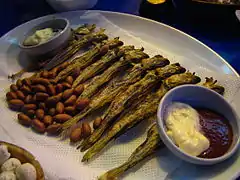Alaska pollock as food
Alaska pollock (Gadus chalcogrammus), a species of cod (Gadus), is an edible fish found in the North Pacific ocean.
Compared with common pollock, Alaska pollock is milder in taste, whiter in color, and lower in oil content. It is a popular choice for fast food restaurants, for example in the McDonald's Filet-O-Fish. It is also commonly packaged into block molds that are deep frozen and used throughout Europe and North America as raw material for high quality breaded and battered fish products.[1]
History
Pollock has been consumed in Korea since the Joseon era (1392–1897). One of its earliest mentions is in the 1652 Diary of the Royal Secretariat, which states that "the management administration should be strictly interrogated for bringing in pollock roe instead of cod roe." [2]
In 1940, Alaska pollock was the most commonly caught fish in Korea, with more than 270,000 tonnes brought in from the Sea of Japan.[3] However, the consumption of Alaska pollock in South Korea dropped to an estimated 260,000 tonnes per year by 2016,[4] Much of is imported from Russia due to changes in sea water temperatures.[5]
Alaska Pollock is a sizeable resource of fish and makes up 32% of the total US landings and 58% of Alaska's.[6] Pollock is the target of many of the world's fisheries and represents about 5% of the world's harvest. In the United States water's alone over 1.5 million mt have been caught, giving an estimated value of 600- 900 million dollars in profit, between the years 1992-1996.[7]
Food
Alaska pollock fillets are layered into a block mold and deep-frozen for distribution. For high-quality products, such as surimi, high-grade fillets are frozen only once between catch and consumer. For lower quality, low-cost breaded and battered fish sticks, double-frozen or minced trim pieces are used instead.
Alaska pollock is commonly used in the fast food industry; in products such as McDonald's Filet-O-Fish sandwich and (now-discontinued) Fish McBites,[8] Arby's Classic Fish sandwich,[9] Long John Silver's Baja Fish Taco,[10] and Birds Eye's Fish Fingers in Crispy Batter.[11] Trident Seafoods and Chuck Bundrant were instrumental in popularizing the fish in the US in the 1980s; prior to then it had been most popularly consumed in Asia.[12]
Korea
.jpg.webp)
Alaska pollock is considered the national fish of Korea.[13][14] Its Korean name, myeongtae (명태), has also spread to some neighbouring countries: It is called mintay (минтай) in Russia, and the roe is referred to as mentai-ko (明太子) in Japan, although the Japanese name for the fish itself is suketōdara (介党鱈).
In Korea, myeongtae has more than 30 alternative names, including:[14]
- saengtae (생태) – fresh Alaska pollock
- dongtae (동태) – frozen Alaska pollock
- bugeo (북어) – dried Alaska pollock
- hwangtae (황태) – "yellow" Alaska pollock
- nogari (노가리) – dried young Alaska pollock
- kodari (코다리) – "nosed" young Alaska pollock
Every part of a myeongtae, including the intestines and the roe, is used in Korean cuisine.
- changnan (창난) – Alaska pollock intestines
- myeongnan (명난) – Alaska pollock roe
Saengtae
Saengtae (생태), which is fresh Alaska pollock, is most often boiled with radish in a kelp-anchovy broth to create a clear soup, saengtae-tang. Another common preparation is myeongate-jeon; pan-fried Alaska pollock patty. Saengseon-gaseu, the fish cutlet, is often made with filleted myeongtae. Fresh myeongtae can also be served raw as hoe, which is usually marinated and sometimes used as a topping for cold noodles.
Fermented products such as sikhae and jeotgal can subsequently be made with saengtae. Production of myeongtae-sikhae involves a fermentation process using the entire fish along with malt and rice, while changnan (창난) (the intestines) and myeongnan (명난) (the roe) are salted to make jeotgal, called changnan-jeot and myeongnan-jeot respectively.
.jpg.webp) Myeongtae-jorim (simmered Alaska pollock)
Myeongtae-jorim (simmered Alaska pollock).jpg.webp) Myeongtae-jeon (pan-fried Alaska pollock)
Myeongtae-jeon (pan-fried Alaska pollock)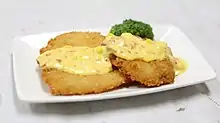 Saengseon-gaseu (Alaska pollock cutlet)
Saengseon-gaseu (Alaska pollock cutlet) Changnan-jeot (salted Alaska pollock intestines)
Changnan-jeot (salted Alaska pollock intestines).jpg.webp) Myeongnan-jeot (salted Alaska pollock roe)
Myeongnan-jeot (salted Alaska pollock roe)
Dongtae
Dongtae (동태), which is frozen Alaska pollock, is typically eaten in a spicy stew, dongtae-jigae. It can also gutted and stuffed with vegetables to make asundae, called dongtae-sundae.
Bugeo
Bugeo (북어), which is dried Alaska pollock, is often boiled in tteumul (water from the final rinsing of rice) to make a clear soup, bugeo-guk. Dried Alaska pollock head, referred to as bugeo-daegari, is a common broth ingredient in Korean cuisine. Other dishes made from bugeo include bugeo-jeok (skewered), bugeo-jangajji (pickled), bugeo-jeon (pan-fried), and bugeo-jorim (simmered). A dish called bugeo-bopuragi, literally "bugeo lint", is made by grating well-dried Alaska pollock into "lint" and seasoning it.
Bugeo can be thinly sliced, seasoned and dried to make fish jerky, called bugeo-po, which can be eaten plain or used as an ingredient in other side dishes.
Hwangtae
Hwangtae (황태), which is yellow Alaska pollock, is made by drying the fish during winter and allowing it to undergo natural freeze-thaw cycles. It is often boiled into a soup called hwangtae-haejang-guk (hangover soup). Rehydrated hwangtae can be grilled (usually with a gochujang-based marinade) as hwangtae-gui, simmered hwangtae-jjim or jorim, or added to hwangtae-juk (rice porridge). Jerky made from yellow Alaska pollock is called hwangtae-po.
 Hwangtae-gui (grilled yellow-dried Alaska pollock)
Hwangtae-gui (grilled yellow-dried Alaska pollock) Hwangtae-haejang-guk (yellow-dried Alaska pollock hangover soup)
Hwangtae-haejang-guk (yellow-dried Alaska pollock hangover soup)
Roe
Alaska pollock roe, generally referred to simply as pollock roe, is a popular culinary ingredient in Japan, Korea, and Russia. In Korea, the roe is traditionally called myeongnan (명란) and the salted roe is called myeongnan-jeot (명란젓). The roe was introduced to Japan after World War II, and is called mentaiko (明太子) in Japanese. The milder, less spicy version is called tarako (鱈子) in Japanese. In Russia, Alaska pollock roe is sold as a canned product suspended in oil, which gives it a soft paste-like consistency.
References
- Portunus. (2014). Alaskan Pollock. Retrieved from http://portunusgroup.com/products/alaskan-pollock/
- Cha, Sang-eun (12 September 2015). "A hit abroad, pollock roe is rallying at home". Korea Joongang Daily. Retrieved 10 January 2017.
- 박, 구병. "명태" [myeongtae]. Encyclopedia of Korean Culture (in Korean). Academy of Korean Studies. Retrieved 10 January 2017.
- Gergen, Eugene (21 November 2016). "South Korea Facing Pollock Shortage, Aims to Rebuild Imports and Trade Ties to Russia". SeafoodNews. Retrieved 10 January 2017.
- Lee, Hyo-sik (19 January 2012). "PyeongChang: birthplace of yellow dried pollack". The Korea Times. Retrieved 10 January 2017.
- Bimbo, A. P. (2013). Sources of omega-3 fatty acids: Walley (Alaska) Pollock. Food Enrichment with Omega-3 Fatty Acids. 2.6.9
- Bailey, K. M., Quinn, T. J., Bentzen, R. and Grant, W. S. (1999). Population structure and dynamics of Walleye Pollock, Theragra chalcogramma. Advances in Marine Biology. 37, 179-255
- Tepper, Rachel (24 January 2013). "McDonald's Sustainable Fish: All U.S. Locations To Serve MSC-Certified Seafood". Huffington Post. Retrieved 9 April 2015.
- "Classic Fish". Arby's. 2014. Archived from the original on 13 April 2015. Retrieved 9 April 2015.
- "Ingredient Statements" (PDF). Long John Silver's. June 2014. Archived from the original (PDF) on 8 September 2015. Retrieved 9 April 2015.
- "Fish Fingers in Crispy Batter". Birds Eye. 2014. Archived from the original on 15 April 2015. Retrieved 9 April 2015.
- Sazonov, Alexander (19 July 2017). "The Man Who Got Americans to Eat Trash Fish Is Now a Billionaire". Bloomberg News. Retrieved 29 July 2017.
- 정, 빛나 (11 October 2016). "국민생선 명태가 돌아온다…세계최초 '완전양식' 성공" [Return of the national fish: the first success in the world in completely controlled culture of Alaska pollock]. Yonhap (in Korean). Retrieved 10 January 2017.
- 박, 효주 (6 January 2017). "동태·북어·노가리, 겨울엔 황태·코다리로… '국민생선' 제철만났네" [Dongtae, bugeo, and nogari; as hwangtae and kodari in winter... the "national fish" is in season]. Bridgenews (in Korean). Retrieved 7 January 2016.
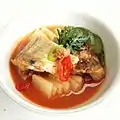
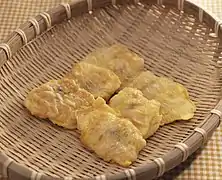
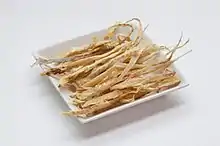

.jpg.webp)
